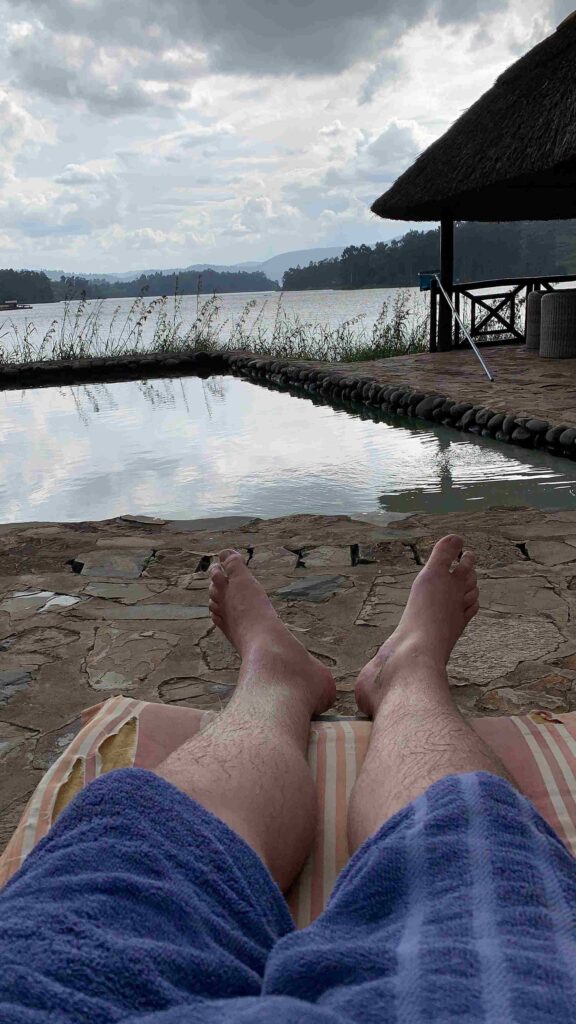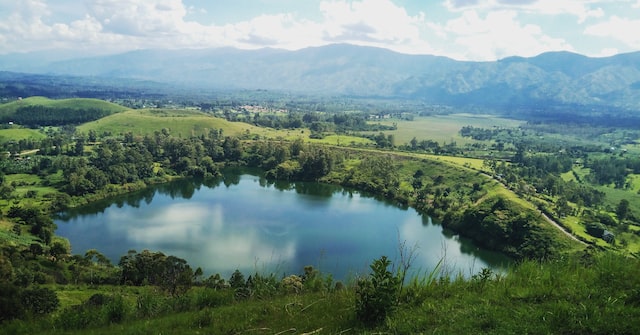Table of Contents
- Where can you go swimming in Uganda?
- Why can’t you swim in all lakes/rivers in Uganda?
- Tips for swimming in Uganda
- Recap: Swimming in Uganda
Swimming in Uganda – what are your options?!
When you schedule a vacation to anywhere in the world that is hot, it’s likely that swimming is at the top of your agenda in order to cool off! As a landlocked country, Uganda doesn’t provide tourists with access to the sea, even though Lake Victoria is essentially an inland sea that is anchored in the center of East Africa.
So, when it comes to swimming in Uganda, what are your options? Can you swim in outdoor lakes, rivers, and streams? What do you need to be aware of?
Having taken a dip in several natural locations in and around Uganda, I explain what your options are for swimming in the country, as well as some of the safety aspects that you need to consider before grabbing your swimming costume.
So, without further ado, let’s dive into the reality of swimming in Uganda.
Where can you go swimming in Uganda?

The safest and easiest place to go swimming in Uganda is in a hotel pool. This might sound like an obvious thing to say, but there are so many international hotels in Entebbe, Kampala, and at other tourist sites throughout the country, meaning that you can cool off and take a break from the African sun.
But what about swimming in Uganda in the great outdoors?
One of the only outdoor water bodies in Uganda declared safe for swimming is Lake Bunyonyi, which is located in the extreme southwestern corner of Uganda, not far from the Rwandan border.
Lake Bunyonyi is breathtakingly beautiful, and it’s an absolute must-visit for anyone spending time in any of the natural attractions in this part of Uganda.
The reason that Bunyonyi is deemed safe is that there aren’t any dangerous animals in the water (no crocs or hippos, for instance), and the water is also deemed to be free from parasites, a big problem that faces other water bodies in Uganda – more on this shortly.
There are other crater lakes in Western Uganda that are locally regarded as safe for swimming – one being Lake Matanda, which is located in Kisoro, not far from Lake Bunyonyi.
While there’s conflicting information about the safety of swimming in the River Nile at Jinja – the river’s source – I have been in the water there on several occasions, as it is the location of white water rafting and other leisure activities. Should you decide to swim at Jinja, you should be aware of the potential dangers of doing so – more on this in the following section.
If you’re planning to swim outdoors in Uganda, you absolutely must seek local guidance beforehand, as conditions can change, and you need to be aware of any environmental factors that may deem a lake or river to be unsafe at a specific time of the year.
Why can’t you swim in all lakes/rivers in Uganda?
There are several reasons why many of the lakes and rivers in Uganda – and the Great Lakes Region more generally – are not safe for swimming.
Dangerous animals
The first is the presence of animals in these water bodies. Uganda is home to a large population of Nile Crocodiles, and I don’t need to tell you that you don’t want to share the water with them!
Granted, most Nile Crocodiles live in and around gazetted national parks like Queen Elizabeth and Lake Mburo, but there are instances where crocs can be found sunbathing on certain river banks – parts of the Nile included.
Another big threat to human life in Uganda is posed by hippos. Hippos are actually one of the deadliest animals, in spite of the fact that they’re herbivores, as they often come into contact with unsuspecting humans who enter their territories for various reasons. Many of the victims of hippo attacks are fishermen, but hippos are extremely aggressive when threatened, so you need to keep a wide berth if they’re in the vicinity.
Like crocs, most hippos in Uganda live in national parks, but again, you should be privy to local guides who are well-positioned to inform you about whether a water body has a population of hippos nearby.
Parasites
Second to threatening animals, the next reason why some water bodies in Uganda aren’t safe is due to parasites. One common parasite found in many water bodies in East Africa is Schistosomiasis – also known as Bilharzia – and it is an infection that is passed on by infected worms.
You can become infected with Bilharzia if you come into contact with contaminated freshwater, so it’s really important to avoid water bodies that are known to have a history of contamination. In Uganda, Lake Victoria is one such source, and it’s not safe to swim in the lake for this reason, above all others.
It’s also important to be aware of the fact that some water sources in Uganda may be contaminated or polluted for other reasons, which is why it’s so important to speak to local guides before taking the plunge into an inviting-looking water source during your upcoming vacation.
Tips for swimming in Uganda

The key thing to remember about swimming in Uganda is that some outdoor water bodies are safe, while others aren’t. This is why it’s so important to consult local guides before heading into an outdoor water body in the country!
But if you are planning to swim outdoors in Uganda, here are some simple tips that you should bear in mind before entering the water:
- Always consult a local guide before entering a water body in Uganda, even if swimming has been declared as a safe activity.
- Never enter a body of water that is in or around a National Park.
- Many of Uganda’s crater lakes are incredibly deep – Lake Bunyonyi, for instance, has a disputed depth of between 900 – 3000 meters.
- Most Ugandans can’t swim and have a general fear of the water. Therefore, you’re unlikely to see many locals swimming in crater lakes, even if it is safe to do so!
- If in doubt, stick to the hotel pool. There are so many hotels in cities and at tourist hotspots around Uganda with swimming pools, meaning you don’t need to risk an outdoor swim if you’re unsure about the safety of doing so.
Recap: Swimming in Uganda
The bottom line is that outdoor swimming in Uganda can be safe, but it depends on where you’re planning to enter the water. Lake Bunyonyi is widely advertised as the safest outdoor swimming spot in the country, and I’ve enjoyed swimming there many times without issue.
Although I’ve mentioned this a few times already, I just want to reiterate the importance of checking with a local guide before going swimming anywhere in Uganda. The last thing you want is to hop into a water body that is contaminated with parasites or home to unseen Nile Crocodiles or Hippos!




